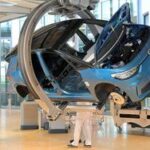It is reported that an increasing number of people are canceling their taxi reservations when they get an electric vehicle (EV). Many even ask for an option to exclude EVs when booking taxis. Would you believe it if the reason for avoiding EVs is motion sickness? While other types of cars are acceptable, some people experience severe motion sickness, specifically in EVs. Let’s explore the reasons why.
What Causes Motion Sickness?

Motion sickness occurs because of conflicting information from the sensory organs and the vestibular system. When the body moves rapidly before the eyes fully process it, the central nervous system gets stimulated, leading to nausea. This sensation is what we refer to as motion sickness.
The Rise of Electric Taxis

The number of electric taxis has increased by over 400% compared to 2020. While they still account for a small percentage of all taxis, the growth rate is steep. This is partly because popular mid-size taxi models like the Hyundai Sonata and Kia K5 have been discontinued, leaving fewer options, prompting drivers to choose EVs with government subsidies. However, as more passengers report motion sickness, the growth of electric taxis is likely to slow down.
Why Does Motion Sickness Happen More in Electric Vehicles?

The regenerative braking system is why people feel more motion sickness in EVs. This system converts kinetic energy generated during deceleration into electrical energy, which helps recharge the battery and extends the vehicle’s range. However, when regenerative braking suddenly changes the vehicle’s speed, it can make passengers feel nauseous.
The Rough Ride of Regenerative Braking

When drivers release the accelerator in a combustion engine vehicle, the speed gradually decreases— in contrast, releasing the accelerator in an EV results in a sharp drop in speed. If the regenerative braking is set to maximum, the deceleration impact increases, making passengers feel like the driver has slammed on the brakes. As a result, people unfamiliar with EVs may find the ride uncomfortable, leading to more passengers avoiding electric taxis altogether.
Quick Starts and Stops

EVs boast faster acceleration than combustion engine cars. This can lead to sudden starts and stops that contribute to motion sickness. Taxis, by their nature, frequently pick up and drop off passengers, which can exacerbate this issue. Additionally, some electric cars are designed with a lower center of gravity, increasing the likelihood of body roll during high-speed cornering, which can also trigger nausea.
Lack of Synchronization Between Driver and Vehicle

Regenerative braking in EVs operates unpredictably, differing from the braking systems in combustion engine cars. In traditional vehicles, the sounds and vibrations from the engine signal the driving conditions, while passengers in electric cars may not anticipate sudden deceleration, causing confusion in their brains and ears, which can lead to motion sickness.
Lack of Fresh Air Could Be a Factor

Some EVs tend to seal their interiors, limiting the influx of outside air. This can lead to a lack of fresh air or increased humidity inside the vehicle, causing discomfort for passengers. It’s advisable to maintain good ventilation and an appropriate temperature inside the vehicle while driving. Opening windows or adjusting the air conditioning can help create a more comfortable environment.
Adjusting the Regenerative Braking System

Drivers are usually aware of when the car might shake, making them less likely to experience motion sickness. However, passengers may not be as prepared. To minimize the nausea experienced by passengers while using the regenerative braking system, it’s beneficial to adjust the system’s strength. Lowering the intensity may lead to more frequent use of the foot brake, which can reduce battery charging. Still, it also provides a feel similar to traditional combustion engine vehicles, potentially decreasing motion sickness.
EVs Are Still Developing

EVs have a shorter development history than combustion engines, which have been studied for decades. Nowadays, some electric cars come equipped with systems that prevent rapid deceleration while still utilizing regenerative braking, and many models allow for adjustments to the regenerative braking strength. However, experts believe it will take time before electric cars can match the level of refinement seen in traditional cars.
Tips to Reduce Motion Sickness in EVs

Taking breaks during long drives is essential. It is recommended to step out of the car, breathe fresh air, and stretch, even for a short while. Maintaining smooth acceleration and deceleration is also beneficial. Driving with predictable patterns can significantly help in reducing motion sickness.















Most Commented